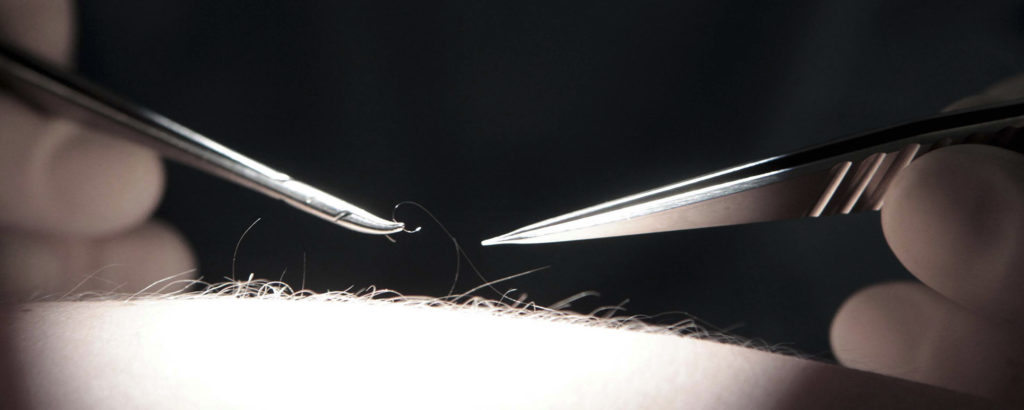Lymphatic surgery in Germany for lymphedema
The underlying problem in lymphedema is the blockage of lymphatic drainage. This causes the lymphatic fluids to remain in the tissue which consequently leads to deposition of proteins and chronic swelling of the affected region.
In addition to the increase in circumference, patients suffering from lymphedema experience the feeling of tension and heaviness of the affected region leading to major restrictions in daily life and thus a reduction in quality of life. Moreover, conservative treatments such as lymphatic drainage and wearing of compression garments are time-consuming and require consistency and compliance. Depending on the gravity of the case infections can further aggravate the illness.
Up until now in most cases conservative measures such as complex physical compression practices (manual lymphatic drainage) and wearing of handmade compression garments were the only treatment option for patients suffering from lymphedema.
There are two types of Lymphedema – primary (congenital) and secondary (acquired) lymphedema. Secondary lymphedema primarily affects extremities (arms and/or legs) usually after extensive lymph node dissections as a part of cancer treatment. It can also be caused by radiotherapy.
20% of all breast cancer patients who have gone through a lymph node dissection (especially when dissecting Level 1 and 2) subsequently experience symptoms correlating to a blockage of the lymphatic drainage.

Lymphovenous Anastomosis (LVA) in „supermicrosurgical technique“
In supermicrosurgical lymph surgery obstructed or damaged lymphatic vessels are connected to small superficial veins distal to the location of defect. This allows for the lymphatic fluids to drain into the venous system and thus reduce swelling of the affected area. This surgery is performed with a microscope under maximum magnification.
Surgery:
The average lymphatic vessel is 0,3-0,8mm in diameter. As the lymphatic fluid, as well as the walls of the vessel are transparent these filigree structures are barely visible to the human eye. Little veins similar in diameter to the lymphatic vessel can be found directly underneath the skin. It takes a lot of microsurgical skill, special surgical instruments and suture material imported from Asia to be able to perform this complex surgery.
Diagnostic:
Using a special photodynamic infrared camera (PDE: Photo Dynamic Eye) and a fluid that is affine to the lymphatic system it has recently been made possible to visualize patients’ lymphatic vessels without any exposure to radiation.
In a co-operation between our clinic and the University hospital of Brussels we are working on an MR-Lymphographic protocol to optimize preoperative visualization of the lymphatic vessels.
Indication and prognosis:
This procedure is especially promising in patients who haven’t been suffering from lymphedema for a long time and whose lymphedema is still reversible (reduction in swelling by manual lymphatic drainage). Regular lymphatic drainage and wearing of compression garments can delay or even stop progression of lymphedema and therefore prolong the timeframe in which LVAs can be installed in supermicrosurgical technique.
Risks:
As the incisions that have to be made are only about 1-2 cm in length, the risks during surgery are very low. Patients suffering from Lymphedema generally have a higher risk for infection of the affected region however as the surgery is performed under sterile conditions and antibiotic prophylaxis the risk is minimal.
Vascular Lymph Node Transfer (VLNT)
VLNT is a procedure that can alleviate symptoms even in advanced and long-standing Lymphedema. A personal consultation can conclude whether this surgery is suitable.
Inguinal or thoracic lymph nodes and their vasculature are transplanted to the affected extremity. Over time these transplanted lymph nodes spout new lymphatic vessels which in further sequence can drain the accumulated lymphatic fluid. Moreover lymph nodes have the ability to act as sponges and therefore absorb surrounding fluids. This leads to the immediate improvement of the symptoms and reduction in circumference.
Do you have any questions about the therapy options?
Call us without obligation and let us advise you on lymphatic surgical treatment:
Kurzinformation
| OP duration: | 1,5 – 2 hours |
| Stay: | Outpatient or 1 night inpatient |
| Suture removal: | 7 days |
| Socially acceptable: | 1 – 3 days |
| Downtime: | 1 – 2 weeks |
Read more information about lymphatic surgery in Düsseldorf and the surrounding area here.